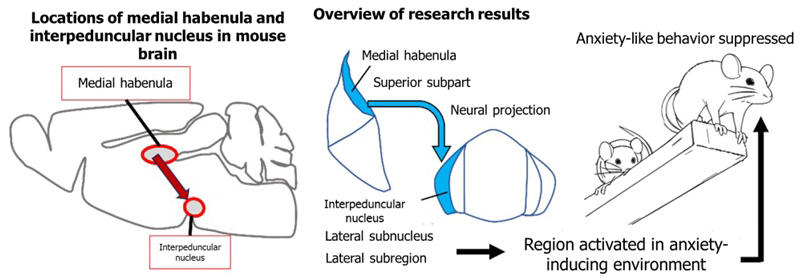A joint research group led by Team Leader Hitoshi Okamoto and Mr. Takehisa Handa (a graduate student at the time of the research) of the Laboratory for Neural Circuit Dynamics of Decision Making at the RIKEN Center for Brain Science (at the time of the research), announced the discovery of a neural circuit that is activated in anxiety-inducing environments and suppresses anxiety-like behavior in mice. This finding is expected to contribute to understanding the mechanisms of excessive anxiety in mental disorders such as anxiety disorders and to developing treatment methods. The results were published in the online edition of the international scientific journal Molecular Psychiatry on March 26.

Provided by RIKEN
While feeling anxiety toward potential dangers and avoiding them is important for the survival of animals and humans, excessive anxiety can prevent adaptation to environmental changes. The neural circuit projecting from the medial habenula to the interpeduncular nucleus in the brain has been conserved in vertebrates through evolution and is involved in controlling emotions such as anxiety and fear. These organs are divided into fine subnuclei, each with different functions. On the other hand, the function of the medial habenula and the lateral subregion of the lateral subnucleus of the interpeduncular nucleus (lLIPN) that receives projections from it on animal emotions was unknown.
In this study, the research group focused on the most lateral region of the interpeduncular nucleus (lateral subregion of the lateral subnucleus). To selectively label and manipulate the lLIPN, they used genetically modified mice expressing Cre DNA recombinase (an enzyme that recognizes specific sequences and causes DNA recombination) in this region. When they visualized the neural cells projecting to the interpeduncular nucleus neurons expressing Cre using viral vectors, it was mainly the superior part of the medial habenula that was labeled. This enabled the analysis of the neurons in the lLIPN that receive projections from the superior part of the medial habenula.
To investigate the effect of neuronal activity in the lLIPN on emotion, the DREADD method was used to selectively activate only neurons expressing Cre, and anxiety-like behavior in mice was evaluated. This method enables artificial manipulation of neuronal activity by expressing artificial receptors in neurons and administering drugs that specifically stimulate those receptors.
As a result, mice with activated neuronal activity in the lLIPN showed reduced anxiety-like behavior. Furthermore, when synaptic transmission-inhibiting proteins were selectively expressed in Cre-expressing IPN neurons to inhibit lLIPN function, anxiety-like behavior increased. It was also confirmed that neuronal activity in the lLIPN is activated in mice exposed to anxiety-inducing environments.
This neural circuit may function as an intrinsic safety net in the brain to prevent excessive anxiety. In humans, too, dysfunction of the medial habenula-interpeduncular nucleus neural circuit may cause excessive anxiety as seen in mental disorders such as anxiety disorders.
Okamoto commented: "We found that the neural circuit from the superior part of the medial habenula (MHbS) to the lLIPN has the function of preventing excessive anxiety. Whether this function of the circuit is acquired depending on past experience or is innate is a subject for future research. People who are not easily disturbed or frightened by minor things are said to have steady nerves. People practice various forms of training to achieve this state, and it would be interesting to know whether this is related to the enhancement of the neural circuit revealed in this study."
Journal Information
Publication: Molecular Psychiatry
Title: The neural pathway from the superior subpart of the medial habenula to the interpeduncular nucleus suppresses anxiety
DOI: 10.1038/s41380-025-02964-8
This article has been translated by JST with permission from The Science News Ltd. (https://sci-news.co.jp/). Unauthorized reproduction of the article and photographs is prohibited.




